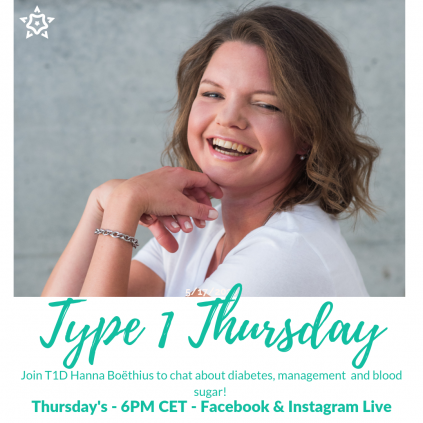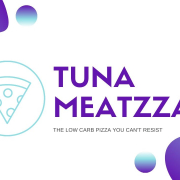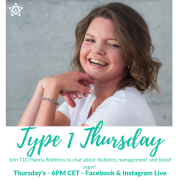Type 1 Thursday – My HbA1c Formula
Lowering your HbA1c as a Type 1 Diabetic is HARD!
How did I turn my double digit HbA1c nightmare into a healthy 5.0% habit? Find out all about my 12 step formula in this week’s Type 1 Thursday!
What is your goal A1c? Or healthy goal in general? Let me know in a comment below!
Transcription
If you prefer to read about my HbA1c Formula, here you go:
Getting your HbA1c down as a Type 1 Diabetic is hard! It’s really, really hard and requires a lot of work and effort. So how did I turn my HbA1c from a double digit nightmare to a 5.0% healthy habit?
In this week’s Type 1 Thursday, with me Hanna Boëthius, one of the cofounders of The Low Carb Universe, as well as a Type 1 Diabetic since 34 years. I don’t know if you know, but I reached something magnificent. I have had a long, long standing dream of reaching a HbA1c of 5.0% (31 mmol/mol) in the “other scale”. This week, I finally got confirmed that this was the case and I couldn’t be happier! But what you may not know about me, yet, at least is that not that many years ago, I was a total diabetic mess. I failed to take care of myself. I had terrible blood sugars and very little knowledge of how to actually manage diabetes. So my A1c not too long ago was in the double digits, which is not good for anyone who knows anything about blood sugar. At the same time, I was so hopeless because I was clearly not given a the proper tools of taking care of my diabetes.
I actually shared my full story a couple of weeks ago, but so that no one else has to go through all the trials and tribulations that I did, I have formulated my getting a better HbA1c formula!
It’s what I have done to bring my HbA1c from double digits to a healthy, happy 5.0 habit. I’ve actually been under 5.5% for more than three years now, something I’m very happy about! That means that it’s stable, that means that I have found out a few things that work for me. That doesn’t necessarily means that they work for every single Type 1 out there, but they work for me. And maybe just maybe you or someone you know will be able to draw a little bit of inspiration from what I’ve done, so that you can get healthier and to your health or A1c goal as well.
This is a 12 point plan, so buckle up and get ready, we have a lot to go through!
Number one is definitely eat low carb. I know, it’s a very heated topic in all of this. But if you have problems with blood sugar, there is really nothing else that will work as well as to lower your intake of dietary carbohydrates. This also means my favorite topic in the world, which is the law of small numbers. Instead of with a lot of carbs, you add a lot of sugar, and then you have to chase it with a lot of insulin and then the margin of error is just equally as big. Instead, you can eat a little sugar, you add a little insulin and the margin of error is smaller. This is the number one reason why low carb for diabetics is such a great idea, because it leaves out so much of the guessing work. I also incorporated intermittent fasting into my routine a good couple of years ago. This means that I skip breakfast every day, just because I’m just not hungry, and I don’t see the point of stressing my body with trying to, to digest more. Intermittent fasting that has helped me a lot, and maybe it’ll help someone out there too.
You have to find out if you are intolerant towards any sort of foods. A very common intolerance is dairy, for example, which is a big thing within low carb. If you have any issues or allergies, then maybe it’s not going to help you reach those blood sugar goals that you are so dearly after. Make sure that you find out other things, for example eggs, night shades… People have intolerances towards many foods, but you might not find out.
What is your personal carb threshold? I know this is also very widely discussed within the diabetic community. I personally eat maybe 20 grams of carbs a day, most days not even. For example, the great Dr. Richard Bernstein says that you should eat 30 grams a day with six grams of carbs for breakfast, 12 for lunch, and 12 for dinner. It’s all up to you finding out what kind of level that you should be at for the best results. This is definitely not carbs from cookies, and pasta, rice, potatoes, all this stuff. This is green leafy vegetables, vegetables that have grown above ground, as these vegetables don’t impact your blood sugar as much.
Treating the few hypoglycemia as that you still will experience, but not as many, with precision so that you don’t go up and down and down and up and up and down as we were used to on the high carb lifestyle that I was on before, but treat lows with precision. Use the exact number of grams of glucose that you need to get into back into a healthy, safe level of blood sugars. If you overshoot too often, then your average blood glucose is going to go up. If you want to bring your A1c down, then make sure that you stay in range as much as possible.
Second point is medication, whatever kind of medication you’re on. Yes, insulin, but I don’t want to discount any other sort of medications you may be on, they may have an impact on your blood sugar, please check this with your doctor. When it comes to insulin, there are two really important things that you have to do: number one, basal rate or your basal dose of insulin, the long acting insulin that should keep you stable throughout the day and night. Please test that this is correctly dosed. If it’s not, then it’s going to cause you to either slowly but surely go up in blood sugar or go down and blood sugar if you’re take too much basal. You can test this by fasting and checking your blood sugar every hour of that fasting window, you can either divide it up or do 24 hours in one go. The second part is of course, bolus insulin, the mealtime insulin. Make sure you know your ratios, and that they are properly calculated, or found out through trial and error, as they are in my case. The common ratio calculations that exists with high carb eating, don’t quite apply to all diabetics eating low carbs. So for very many of us it has to become a trial and error. With a law of small numbers, the error margin is not that big. So you’re not going to be in for a wild ride. It takes some time to figure it out.
Also pre bolus for your meals, even if they don’t contain that many carbs, just so that the insulin has a bit of time to start working before the food comes and does the same. What really helps when you’re trying to find out your medication and ratios and pre bolusing for meals, and everything else, is of course to have a continuous glucose monitor. This is either Dexcom, for example, or Freestyle Libre, or any of the other ones that are out there, whatever one fits you the best. I know they’re very expensive, and they’re very hotly debated as well. But they are a huge, huge help when it comes to really lowering your A1c, because when you see a trend you can start acting before the catastrophe is a fact, hyper or hypo.
The next point, is blood sugar levels. As a perfect diabetic, or whatever that means, you should try to aim for an average of 4.6 mmol/l or 83 mg/dl. This is what people who are healthy and have a functioning pancreas’ are on average. If you are at a much higher average right now, don’t try to get down to 4.6 or 83 in one go, do it step by step. All of the modern blood sugar meters have an average measurement of blood sugar. Depending on how often you prick your finger, it might may be representative of what it actually looks like. As soon as you see where that average is, just try to aim for values slightly below that. You will slowly but surely take it down to normal healthy levels and therefore achieve a normal healthy A1c. You HbA1c, in short, it’s the average blood sugar for the past sort of six to eight to 12 weeks.
How you correct blood sugar also matters! Don’t be aggressive about it, whether you have to correct a hypo or a hyper. That causes the large margin of error. Be careful about it, and have a little bit of patience. I’m the worst person to talk about this, as I have zero patience! Be sure that you have a little bit of patience when you do treat, as things can turn quite suddenly. Find out if you are affected by the dawn phenomenon, for example, which is when the liver kicks in and starts shooting out sugar so that you wake up in the morning. Or if you have something that is called boots on the ground syndrome, which is when you are have woken up and you put your feet on the ground and the stress of your day gets your liver going and your blood sugar consequently goes up. Those can also be fine tuned with basal insulin, which needs to be handled by a doctor.
Then number next is stress. Stress is a really a blood sugar killer! It really aggravates your whole system, and it causes your blood sugars to go up. Make sure that you can prevent and avoid as much stress as you can in your every day life. How can you reduce it? Well, you have to find what works for you. Could it be yoga? Could it be meditation? Could it be a long walk in the nature? Could it be a hobby, could it be having a pet? Stress is really something that we have to work all of us, but especially people with glucose problems need to work hard at trying to eliminate it.
Next point, movement. I don’t like the word exercise, so I’m going to use movement. Our bodies are made to be moving and our bodies feel good if they get to move often and in different ways. Find out what makes you happy. What is fun for you, what way of moving is so fantastic that you just forget about time? It could be dancing, it could be the ones that I mentioned before, yoga, walking. It could be weight training, it could be dancing on the beach (which we do happen to do in Mallorca! If for nothing else, join us to find out how much fun that is in November.)
Movement has a very individual reaction on blood sugar. In the long run it definitely smooths things out. But when you’re doing exercise, or you’re moving vigorously, chances are that your blood sugar is going to go up. You need to find out what strategy works best for you. There is a rule of thumb – strength training makes your blood sugar up and cardio makes your blood sugar go down. But that’s not true for everyone, that’s just a rule of thumb! You have to find out what works for you and what happens to your body in different movement situations.
Next point is planning. Make sure that you are prepared for basically anything when it comes to diabetes. If you’re traveling, carry a glucagon kit, always have glucose tabs with you, no matter where you go. And even if you’re only doing a quick run, make sure that you are prepared for anything that can happen.
No matter how great of control you have of diabetes, things still do happen. Please be prepared for all eventualities at all times. For example, also bring enough test strips for your blood sugar meter, make sure that your insulin pump or your vials have enough insulin in them for the day or the time you’re going to be away. It is all about planning. It really is about treating and treating blood sugar – if you fail to plan, you really plan to fail. Don’t get caught in that trap. That can save you a lot of “interesting” moments with diabetes.
Next point is mindset. What is your goal? Set a clear, actionable, timely goal. Also make a plan of how you’re going to get there. Without motivation and a proper mindset, you aren’t going to reach your goals.
Next one, acceptance. Accept that diabetes is what it is, life still happens with it. And you can only do the best you can, and you can only do the best that works for you. You can’t do much more than that. And please don’t hate diabetes! The more you make it your enemy, the more it’s going to lash right back at you and you’re not going to be able to work with it, which is what you have to do. You have to be kind to yourself, you have to show yourself some love, even when things go wrong. That way you’re going to get to a better relationship with your diabetes, which is also a huge point.
Find your support network, whether that is that our coaches, CDE’s and nurses, doctors, spouses, personal trainers, and other happy people around you, like your friends, family, pets – all of these people that that create the network around you. Make sure they are supportive. This is who you turn to when you have a bad day, or when you want to celebrate a fantastic achievement. You don’t have to sit there by yourself, you can turn to other people and let them help you both in good times and in bad. When it comes to the medical side of your support network, please make sure that you have a Medical Dream Team. This is a key to getting the care that you know that you need, and to try to find out what works best for you. This is where you can really get support for your lifestyle choices, and also help you with your diabetes management.
Hydration, you have to hydrate! Make sure that you hydrate properly, because this helps the body to keep all that, perhaps, unnecessary sugar at bay. The body really does well when it is well hydrated. I personally try to aim for about two liters of clean water a day. It doesn’t have to be that for you.
Finding a routine that works for you . A daily routine, as in you get up sort of the same time in the morning, you go to bed sort of the same time at night, and everything in between. Of course you should be spontaneous and have fun, too! But the main parts that could have a little bit of a structure will help you manage your blood sugars better. Perhaps this could include when you take your basal injection, if you’re on pens or syringes, or when you change your pump site. Also work into your routine when you take your supplements, when and how much you hydrate, when you eat, what you eat, when you move… Building it into a routine is great, because blood sugars, as far as I’m concerned, aren’t too happy about uneven routines, they tend to do better when there is a routine, so that you know what you’re doing.
My final point are supplements. Some potentially blood sugar lowering supplements may be of use. The ones that I take, for example, are omega 3, vitamin D (helps autoimmunity) magnesium (high blood sugars do require a lot of magnesium), also zinc for the immune system. Chromium also can help keeping your blood sugar levels a little bit more stable, as it helps with insulin sensitivity way down in the cells. Also, I’ve heard a lot of good things, but I haven’t tried it myself yet, about alpha linoic acid, ALA.
These are my 12 steps of what I did, and my HbA1c formula to lower mine from a double digit nightmare to a healthy and happy 5.0% (which actually in fact, if I get to brag for a second, is better than even some healthy people have!). I’m very very proud of myself, especially after 34 years of living with this disease and it not having been very easy at for very long periods of time.
What is your A1c goal (or if you are not focusing on A1c – what is your health goal)?
Let me know in a comment and I’ll be happy to chat with you there.










Leave a Reply
Want to join the discussion?Feel free to contribute!